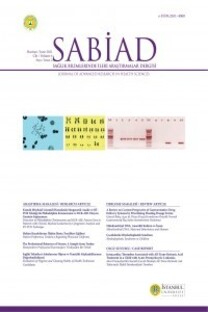INVESTIGATION OF METHYLATION AND EXPRESSION STATUS OF PAX1 GENE VIA EPIGENOMIC PROFILING IN ORAL MALIGNANT LESIONS
OSCC, hypermethylation, epigenetic biomarker, PAX1
INVESTIGATION OF METHYLATION AND EXPRESSION STATUS OF PAX1 GENE VIA EPIGENOMIC PROFILING IN ORAL MALIGNANT LESIONS
OSCC, hypermethylation, epigenetic biomarker, PAX1,
___
- Dela Cruz CS, Tanoue LT, Matthay RA. Lung cancer: epidemiology, etiology, and prevention. Clin Chest Med. 2011;32(4):605-44.
- Yayın Aralığı: Yılda 3 Sayı
- Başlangıç: 2018
- Yayıncı: İstanbul Üniversitesi
İpek GÜRKEBABÇI, Basak KOCDOR, Hilal KOÇDOR
EFFECT OF THYMOQUINONE IN COMBINATION WITH NIVOLUMAB ON EXPERIMENTAL RENAL CELL CANCER MODELS
Ahmet DİRİCAN, Safiye AKTAŞ, Tekincan Çağrı AKTAŞ, Aylin EROL, Özde Elif GÖKBAYRAK, Efsun KOLATAN, Efe Özgür SERİNAN, Zekiye ALTUN, Işıl SOMALI, Osman YILMAZ
APPLICATIONS OF TRANSCRIPTOMICS METHODS IN BREAST CANCER
THE EFFECT OF SILENCING THE Tip60 GENE ON THE RESPONSE TO RADIOTHERAPY IN BREAST CANCER CELLS
Ece MİSER SALİHOĞLU, Bensu KARAHALİL, Sevgi AKAYDIN
ANALYSIS OF TRIBBLES HOMOLOG 3 (TRIB3) EXPRESSION LEVELS IN NEUROBLASTOMA: PRELIMINARY STUDY
Burçin BARAN, Gamze SANLAV, Deniz KIZMAZOĞLU, Selen KUM ÖZŞENGEZER, Safiye AKTAŞ, Zekiye ALTUN, Nur OLGUN
CircRNAs OF SALIVA AS POTENTIAL BIOMARKERS FOR COLORECTAL CANCER DIAGNOSIS
Afet SATTAROVA, Milad ASADİ, Tayfun YOLDAŞ, Osman BOZBIYIK, Ahmad AL-OMAR, Can MUFTUOGLU, Ufuk MERT, Ayşe CANER
EVALUATION OF EXOSOME-DERIVED CircRNA EXPRESSION PATTERNS IN LUNG CANCER RADIOTHERAPY
Saina RAHİMİ, Milad ASADİ, Can MUFTUOGLU, Emin TAVLAYAN, Ozlem OZKAYA AKAGUNDUZ, Ufuk MERT, Ayse CANER
miRNA-REGULATED PATHWAYS OF CD8+T CELLS IN TNBC MOUSE MODEL
Muge OCAL-DEMİRTAS, Doç. Dr. Bala GÜR DEDEOĞLU
NEXT-GENERATION SEQUENCING IN CANCER: GENETIC DIAGNOSIS, RISK PREDICTION AND CLASSIFICATION
